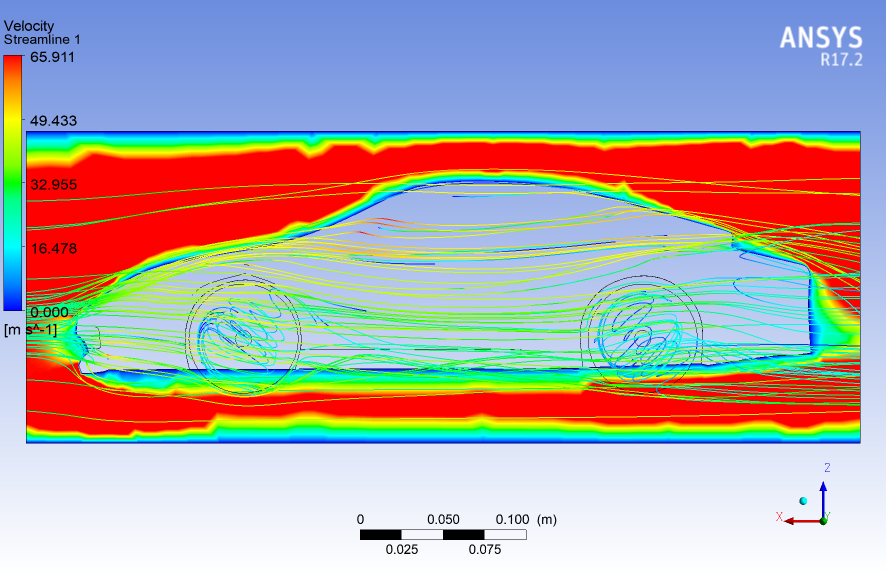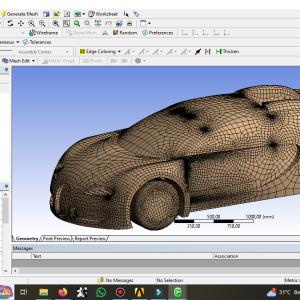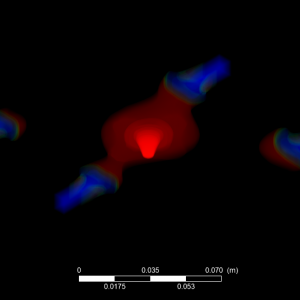The Design – Smooth and Stable Airflow Around Porsche 911 Car at 100 Km/H of Speed | ANSYS Fluent
This simulation is about a Turbulent Air Flow around Porsche 911 Car via ANSYS Fluent software. We perform this CFD project and investigate it by CFD analysis.
Turbulent airflow around a car is the chaotic, disordered motion of air created when it detaches from the vehicle’s surface, significantly increasing aerodynamic drag, reducing fuel efficiency, and generating noise. Automobile manufacturers strive to minimize this turbulence through aerodynamic design to improve stability, fuel economy, and passenger comfort.
How Turbulence Occurs :
- Air Separation: As air flows over a car’s body, it can “separate” from the surface, especially at the rear. This detachment is caused by the airflow’s reduced momentum and the pressure gradient behind the vehicle.
- Vortex Formation: Separated air creates complex, swirling patterns called vortices.
- Complex Flow Patterns: The combination of air separation and vortices leads to a three-dimensional, unsteady, and disordered flow pattern known as turbulence.
- Wheel Housing: The rotating wheels and the airflow entering the wheel housing also contribute to the complex patterns and turbulence around the tires.
Effects of Turbulence on Cars :
- Increased Drag: Turbulent flow creates larger low-pressure wakes behind the car, which act as a significant resistance force, or drag.
- Reduced Fuel Efficiency: Increased drag requires more engine power to maintain speed, leading to higher fuel consumption.
- Decreased Handling Stability: Turbulent air affects the airflow around the vehicle’s body and wheels, potentially reducing handling stability and traction.
- Increased Noise: The interaction of turbulent air with the car’s body generates aerodynamically induced noise.
How Aerodynamic Design Addresses Turbulence :
- Smoother Surfaces: Minimizing gaps and making the car’s body as smooth as possible helps prevent air from separating.
- Optimized Shapes: Designing the body with optimized shapes and features (like specific tire sidewall designs) helps control airflow and reduce turbulence.
- Reduced Drag: The primary goal of aerodynamic design is to reduce air resistance, and managing turbulence is a key aspect of achieving this.
This analysis has tried to simulate and analyze the modeling of Turbulent Air Flow around Porsche 911 Car using ANSYS Fluent software.
Geometry & Grid
The geometry required for this analysis was generated by Ansys Design Modeler software. The meshing required for this analysis was also generated by Ansys Meshing software. The mesh type used in this analysis is unstructured. The total number of volume properties for geometry is 9,1252e-003 m³.
Model
In this analysis, the k-epsilon (2 equation) turbulence viscosity model is used to check the fluid flow. The standard wall function is used near the wall.
Boundary Condition
The flow of primary input design modeler geometry for this analysis is considered as velocity magnitude and is 27.777 (m/s). The flow output range is also considered as a pressure outlet for the flow output region and gauge pressure is equal to 0 (pascal). The inner wall is also considered a Stationary Wall.
Discretization of Equations
According to the type of flow, the SIMPLE algorithm is used to discretize the Pressure-Velocity Coupling of the solution method. The turbulent kinetic energy & turbulent dissipation rated has been discretized in the Second Order Upwind.
The Design Services
We also accept all CFD projects using ANSYS Fluent and ANSYS CFX. Our workshop has gathered experts in different engineering fields so as to ensure the quality of CFD simulations. One of our objectives is to boost the use of powerful computational fluid dynamics methods and also teach the engineers and those who seek professional knowledge in CFD.
ِDoing CFD projects will be faster and easier with our services. Call us for training in CFD applications and CFD packages. Our professional CFD engineers offer you professional consultation and technical supports for your academic CFD projects and industrial CFD projects. We offer you CFD learning, CFD project by ANSYS Fluent and ANSYS CFX, CFD consulting by ANSYS Fluent and ANSYS CFX, CFD service by ANSYS Fluent and ANSYS CFX, ANSYS Fluent and ANSYS CFX project, ANSYS Fluent and ANSYS CFX thesis, ANSYS Fluent and ANSYS CFX simulation, ANSYS Fluent and ANSYS CFX paper regeneration, ANSYS Fluent and ANSYS CFX academic project, ANSYS Fluent and ANSYS CFX industrial project, ANSYS Fluent, and ANSYS CFX research project, and low CFD Price. Moreover, we have years of experience in coordinating CFD projects. Therefore, we are ready to perform your CFD simulations in different engineering fields.






Reviews
There are no reviews yet.